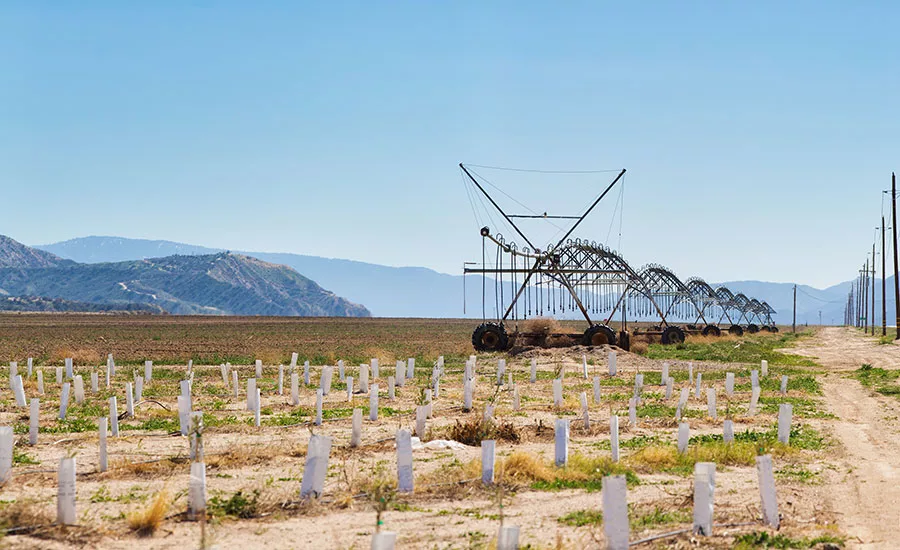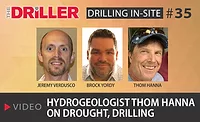Hydrogeologist Talks Well Design, Development in Drought Areas
Thom Hanna Discusses Water Quality, Materials Choices

From ag wells to small domestics, changing groundwater levels can mean major changes to both the quality and quantity of water pumped to the surface.
Source: Getty Images

Hydrogeologist Thom Hanna speaks at the 2019 Mountain States Ground Water Expo in Laughlin, Nevada. Parts of Nevada, California and other western states face historic droughts.
Source: Jeremy Verdusco
Droughts this year have affected large parts of the United States. California and Minnesota have made national headlines, but Arizona, Idaho, Oregon and Utah have also seen drought conditions. Drillers and other industry professionals working in these areas know that water systems from residential wells all the way up to large municipal wells can face a lot of stress.
We spoke with hydrogeologist Thom Hanna to get a handle on how drillers can balance materials and depth choices as water levels and quality fluctuate.
“The conversation we need to have is, what is the best value? It’s a value proposition for all these well owners, whether it’s a homeowner, a domestic well, a mine dewatering well, a municipal well,” Hanna says. “We want to talk about a value proposition, not a cost proposition of what this well is going to cost today. What is going to be the best value over the life of that well?”
Hanna’s books include working on the third edition of “Ground Water and Wells” and “The Operational Stage of the Well.” He’s spent more than 20 years with Johnson Screens, but also has an extensive background as a consultant on well projects in water well, mining and remediation.
We had Hanna on our Drilling In-Site video and podcast series to talk about drought and issues related to drought drillers want to know about. This is an edited summary of our talk. Click here to see the full video, or here to listen to the podcast.
Q. I’ve read a lot this summer about persistent drought in large parts of Arizona, California, Idaho, Minnesota, Oregon and Utah, as well as more locally in other U.S. states. From a hydrogeologist’s perspective, how do these current drought conditions compare to earlier droughts?
A. Yeah, we’ve seen droughts. They seem to be more intense. They seem to result in warmer temperatures. I’ll just go there: global warming. Now that’s stressing out the whole systems of municipalities, small water systems. It’s really a trickle-down effect. It’s not just the drought itself. It’s also higher temperatures that are really straining these systems.
Then you double on top of that. So let’s look at Lake Powell. I’ll just talk about something that’s near and dear to us people in southwestern Colorado. We’ve had to empty a couple of reservoirs. Blue Mesa Reservoir has had to be emptied to fill Powell because now the water levels approach the penstocks. Navajo (Reservoir) too has been drained for power generation. This is, you know, directly drought-related. But think about how that, pardon the pun, drills down into what we do. That’s putting a stress ion the water resources, which now are putting a stress on the wells. So it’s all connected. All these things are connected. So the drought is having a significant impact.
Q. How long can a well last today versus 10 years ago?
A. There’s two parts to that question. One part we’re seeing in Arizona, which is directly drought-related ... [is] where the water levels are dropping significantly. Because the hydrogeology of the basins, originally those wells were shallower. Due to drought conditions, those wells are not deep enough now. Some of them that are deep enough, now we’re drawing the water levels down into the screen sections of the wells. That is reducing the well life, causing issues to the pumping equipment, entrained air, and lack of production as well. So there’s one side of it. There is a depth component, if you will, or design depth component, that wasn’t anticipated when those wells were completed.
The second part is what I’d call a materials issue. … As the aquifers change and if we are anticipating lower water levels, how do we change that design? One thing might be material selection. … Now we have oxygenated water coming into those wells. Maybe for peak pumping capacity, we’re willing to live with a well that has cascading water to meet those peak demands. This relates back to what I was talking about before. So now we have warmer temperatures in the summer. We’re having higher peaks. We’re stressing the system. Now — and with ag wells, this is a common issue with ag wells — we’re going to live with designs that have cascading water. That’s going to reduce the well life. Now, are we going to switch to materials that are going to be more corrosion resistant knowing that’s going to be just part of the norm moving forward?
Q. What changes to well design have you seen deployed for areas dealing with these conditions? Are there screening, pump or casing considerations we need to think about?
A. I think we have to look at the aquifer as a whole. Do we have more aquifer down below where we’ve traditionally drilled? That might be the case. Maybe we have to take water of lesser quality. Some of this water of lesser quality might have constituents that are very corrosive as well. We’re seeing more of that. … If you look at El Paso, for example, El Paso is pumping water that has high, high chloride concentrations. So very corrosive waters. In fact, all of their wells top to bottom are now 3/16 stainless steel. So here is a engineering design to help extend the life of those wells because we’re having to take water of such poor quality. I think we’re going to see more of that in different places. Part of that, as well, we’re probably going to start taking water which may not be of chloride concentration, but maybe arsenic or some other constituents that have been of concern. It’ll either require treatment, blending or some other things as well. These are all drought-related issues.
Q. What ideas or practices would you like to see drillers adopt to create better producing wells?
A. As a driller, number one, it’s almost back to the future. I think, back in the day … there was a real emphasis on development. I think that actually goes back to cable tool drilling. A couple of things about cable tool drilling is, I think, because of the time it takes to drill a well, they didn’t think too much about, you know, “Boy, I’m going to have to spend, you know, weeks developing the well.” So the wells, I think, were much better drilled.
I think also there’s that drilling fluids component in there, too. You don’t have that issue as well, so they develop up a lot faster.
The other part of it is rotary drills, they’re expensive machines. If you’re not out there making money with them — and development’s not a huge moneymaker, right? — if you’re not constructing wells with them, it’s pretty hard to pay those off. While they’re very quick and efficient, and they’ve allowed contractors to make more money, I think we really have to kind of look back at what we used to do in the past. How we how can we develop these wells up better using these new technologies?
The Full Interview
We interviewed Thom Hanna of Johnson Screens for episode 35 of our Drilling In-Site series. Our talk covered synthetic gravel packs, well design mistakes and other topics. See the conversation at www.thedriller.com/insite, or listen to the podcast version at www.thedriller.com/insite-podcast. Episodes also in Apple’s Podcast store. Search Drilling In-Site and tap Subscribe.
Working on an interesting project or have industry wisdom to share? Email verduscoj@bnpmedia.com to be considered for a guest spot on Drilling In-Site.
Looking for a reprint of this article?
From high-res PDFs to custom plaques, order your copy today!









